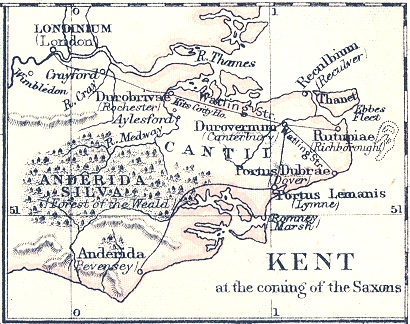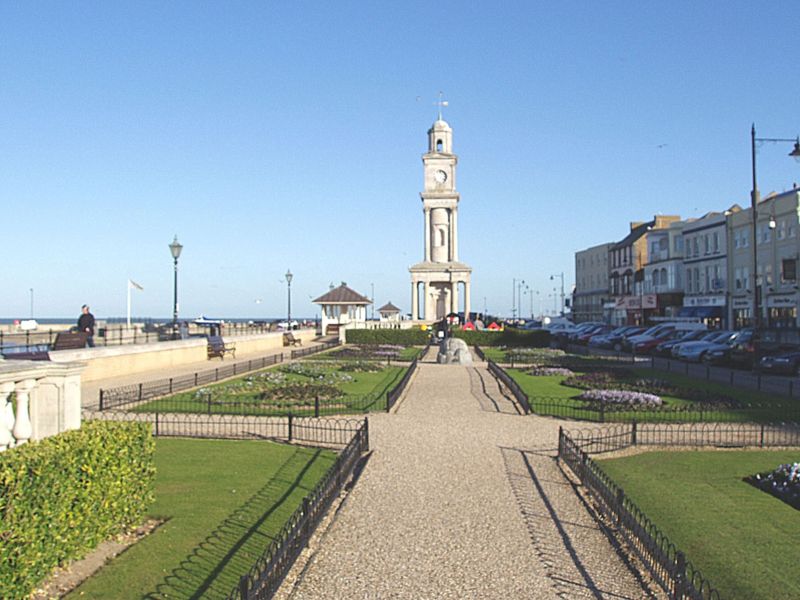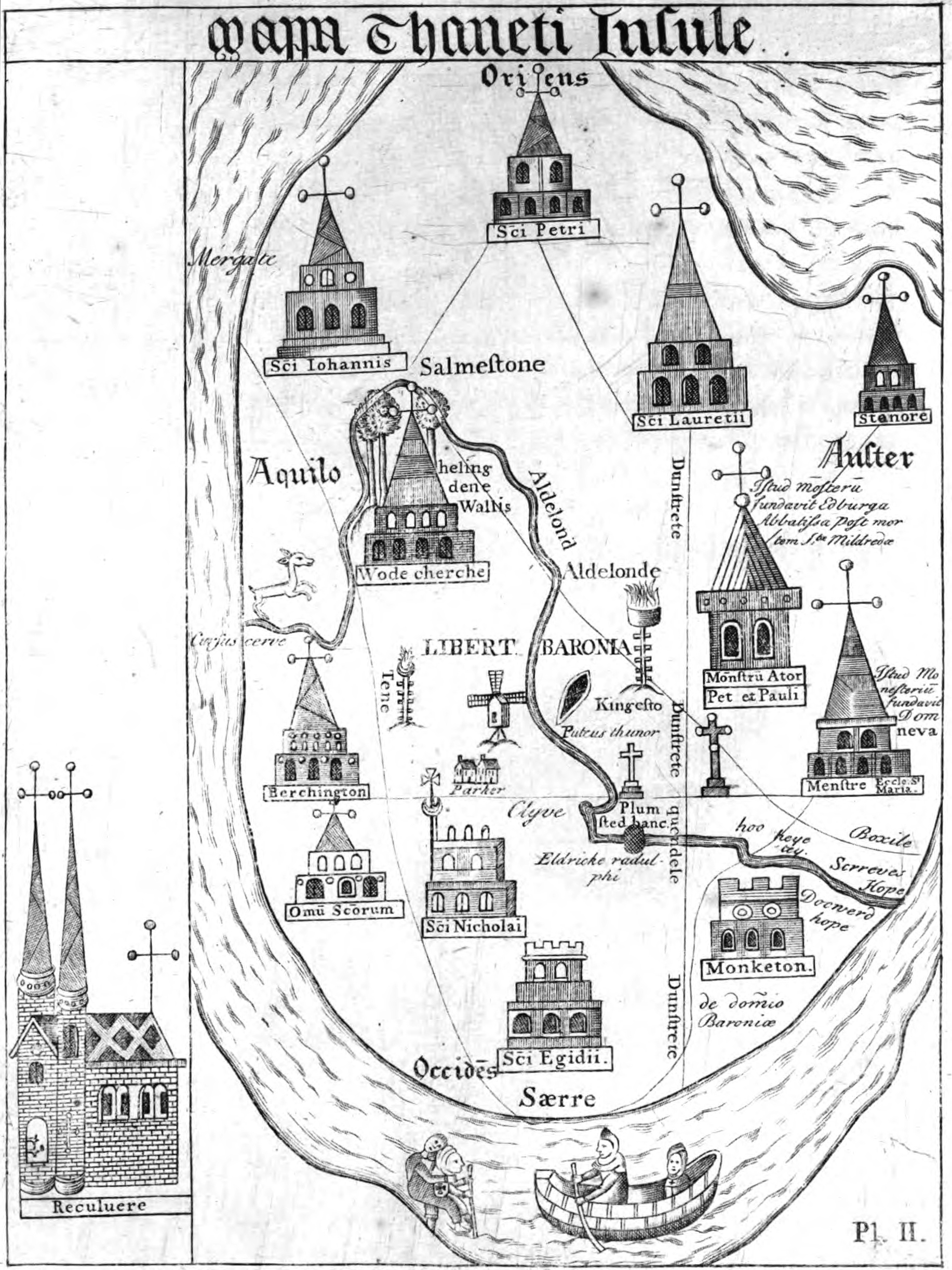|
Reculver
Reculver is a village and coastal resort about east of Herne Bay on the north coast of Kent in south-east England. It is in the Wards of the United Kingdom, ward of the same name, in the City of Canterbury district of Kent. Reculver once occupied a strategic location at the north-western end of the Wantsum Channel, a sea lane that separated the Isle of Thanet and the Kent mainland until the late Middle Ages. This led the Roman Empire, Romans to build a small fort there at the time of their Roman conquest of Britain, conquest of Britain in 43 AD, and, starting late in the 2nd century, they built a larger fort, or Castra, ''castrum'', called ''Regulbium'', which later became one of the chain of Saxon Shore forts. Following the withdrawal of the Western Roman Empire in ca. early C4th, the Brythons again took control of the lands until Anglo-Saxon invasions shortly afterward. By the 7th century Reculver had become a landed estate of the Anglo-Saxon England, Anglo-Saxon Kin ... [...More Info...] [...Related Items...] OR: [Wikipedia] [Google] [Baidu] |
St Mary's Church, Reculver
St Mary's Church, Reculver, was founded in the 7th century as either a minster or a monastery on the site of a Roman fort at Reculver, which was then at the north-eastern extremity of Kent in south-eastern England. In 669, the site of the fort was given for this purpose by King Ecgberht of Kent to a priest named Bassa, beginning a connection with Kentish kings that led to King Eadberht II of Kent being buried there in the 760s, and the church becoming very wealthy by the beginning of the 9th century. From the early 9th century to the 11th the church was treated as essentially a piece of property, with control passing between kings of Mercia, Wessex and England and the archbishops of Canterbury. Viking attacks may have extinguished the church's religious community in the 9th century, although an early 11th-century record indicates that the church was then in the hands of a dean accompanied by monks. By the time of Domesday Book, completed in 1086, St Mary's was serving as a p ... [...More Info...] [...Related Items...] OR: [Wikipedia] [Google] [Baidu] |
Regulbium
Regulbium was the name of an ancient Roman fort of the Saxon Shore in the vicinity of the modern English resort of Reculver in Kent. Its name derives from the local Brythonic language, meaning "great headland" (*''Rogulbion''). History The first Roman military installation in the area was a small fort built directly after the invasion of Britain in the reign of Claudius, protected by earthworks. It was connected to Durovernum (Canterbury) by a road. The fort, strategically located at the entrance of the Wantsum Channel, possibly housed a signal tower, perhaps a lighthouse, and continued in operation at least until the late 60s, since coins dating to the reign of Nero were found on site. This structure lay within the bounds of the later, larger stone fort, which was built in the early 3rd century, probably in , since the sole stone inscription found at the fort (in 1960) mentions the then governor of Britain, Aulus Triarius Rufinus. This construction occurred at a time when ... [...More Info...] [...Related Items...] OR: [Wikipedia] [Google] [Baidu] |
Herne Bay
Herne Bay is a seaside town on the north coast of Kent in South East England. It is north of Canterbury and east of Whitstable. It neighbours the ancient villages of Herne, Kent, Herne and Reculver and is part of the City of Canterbury local government district, although it remains a separate town with countryside between it and Canterbury. Herne Bay's seafront is home to the world's first freestanding purpose-built Clock Tower, Herne Bay, Clock Tower, built in 1837. From the late Victorian period until 1978, the town had the second-longest Herne Bay Pier, pier in the United Kingdom.Herne Bay Pier at www.theheritagetrail.co.uk (accessed 7 July 2008) The town began as a small shipping community, receiving goods and passengers from London en route to Canterbury and Dover. The town rose to prominence as ... [...More Info...] [...Related Items...] OR: [Wikipedia] [Google] [Baidu] |
Wantsum Channel
The Wantsum Channel was a strait separating the Isle of Thanet from the north-eastern extremity of the English county of Kent and connecting the English Channel and the Thames Estuary. It was a major shipping route when Britain was part of the Roman Empire, and continued in use until it was closed by silting in the late Middle Ages. Its course is now represented by the River Stour and the River Wantsum, which is little more than a drainage ditch lying between Reculver and St Nicholas-at-Wade and joins the Stour about south-east of Sarre. Toponymy Eilert Ekwall, a 20th-century authority on English place-names, wrote that the name "Wantsum" derives from an Old English word "wandsum", meaning "winding". Bede, writing in or before 731, mentioned the Wantsum (''Vantsumu'') in describing the Isle of Thanet, but he also recorded an alternative name: he described the church at Reculver as being ''juxta ostium aquilonale fluminis Genladae'', or "by the north mouth of the river G ... [...More Info...] [...Related Items...] OR: [Wikipedia] [Google] [Baidu] |
Saxon Shore
The Saxon Shore () was a military command of the Late Roman Empire, consisting of a series of fortifications on both sides of the English Channel. It was established in the late 3rd century and was led by the " Count of the Saxon Shore". In the late 4th century, his functions were limited to Britain, while the fortifications in Gaul were established as separate commands. Several well-preserved Saxon Shore forts survive in east and south-east England. Background During the latter half of the 3rd century, the Roman Empire faced a grave crisis: Weakened by civil wars, the rapid succession of short-lived emperors, and secession in the provinces, the Romans now faced new waves of attacks by barbarian tribes. Most of Britain had been part of the empire since the mid-1st century. It was protected from raids by native Celtic Britons in the north by the Hadrianic and Antonine Walls, while a fleet of some size was also available. However, as the frontiers came under increasing extern ... [...More Info...] [...Related Items...] OR: [Wikipedia] [Google] [Baidu] |
Kingdom Of Kent
The Kingdom of the Kentish (; ), today referred to as the Kingdom of Kent, was an Early Middle Ages, early medieval kingdom in what is now South East England. It existed from either the fifth or the sixth century AD until it was fully absorbed into the Kingdom of Wessex in the mid-9th century and later into the Kingdom of England in the early 10th century. Under the preceding Roman Britain, Romano-British administration the area of Kent faced repeated attacks from seafaring raiders during the fourth century AD. It is likely that Germanic-speaking ''foederati'' were invited to settle in the area as mercenaries. Following the end of Roman administration in 410, further linguistically Germanic tribal groups moved into the area, as testified by both archaeological evidence and Late Anglo-Saxon textual sources. The primary ethnic group to settle in the area appears to have been the Jutes: they established their Kingdom in East Kent and may initially have been under the dominion of the ... [...More Info...] [...Related Items...] OR: [Wikipedia] [Google] [Baidu] |
Isle Of Thanet
The Isle of Thanet () is a peninsula forming the easternmost part of Kent, England. While in the past it was separated from the mainland by the Wantsum Channel, it is no longer an island. Archaeological remains testify to its settlement in ancient times. Today, it is a tourist destination, and has an active agricultural base. Etymology The island of Thanet is mentioned as ''Tonetic'' (c. AD 150; the TON- of this form was misread as TOΛI-, hence it appears as ''Toliatis'' in the surviving manuscripts of Ptolemy); ''Tanat's'', ''Athanatos'' and ''Thanatos'' (in various copies of 3rd C AD, Solinus); ''Tanatos'' (AD 731); ''Tenid'' in 679 and ''Tenet'' (e.g. charters of AD 679, 689 and thereafter); and the Old Welsh forms ''Tanet'' and ''Danet'', found in the ''Historia Brittonum'' (c. AD 829/30) and Armes Prydein (c. AD 930). Standard reference works for English place-names (such as Eilert Ekwall's ''Concise Oxford Dictionary of English Place-Names'') state the name ''Tane ... [...More Info...] [...Related Items...] OR: [Wikipedia] [Google] [Baidu] |
Bishopstone Cliffs
Bishopstone Cliffs is a Local Nature Reserve in Reculver on the eastern outskirts of Herne Bay, Kent. It is owned and managed by Canterbury City Council. It is part of Thanet Coast Site of Special Scientific Interest, and Thanet Coast and Sandwich Bay Ramsar site and Special Protection Area. This is a grassland site on the top of cliffs, and it has some rare insect species. Sand martins nest in holes in the cliffs, and other birds include skylarks, meadow pipit The meadow pipit (''Anthus pratensis'') is a small passerine bird that breeds throughout much of the Palearctic, from south-eastern Greenland and Iceland east to just east of the Ural Mountains in Russia, and south to central France and Romania; ...s and corn buntings. There is public access to the site, most of which is within Reculver Country Park. References {{Local Nature Reserves in Kent Local Nature Reserves in Kent ... [...More Info...] [...Related Items...] OR: [Wikipedia] [Google] [Baidu] |
Cinque Ports
The confederation of Cinque Ports ( ) is a historic group of coastal towns in south-east England – predominantly in Kent and Sussex, with one outlier (Brightlingsea) in Essex. The name is Old French, meaning "five harbours", and alludes to the original five members (Hastings, New Romney, Hythe, Kent, Hythe, Dover and Sandwich, Kent, Sandwich). At its peak in the Late Middle Ages, the confederation included over 40 members. There is now a total of 14 members: five "head ports", two "ancient towns" and seven "limbs". The confederation was originally formed for military and trade purposes, but is now entirely ceremonial. The ports lie on the western shore of the English Channel, where the crossing to the European continent is narrowest. Inhabitants of the Cinque Ports are called ''Portsmen''. Origins The origins of the confederation are obscure, but are believed to lie in the late History of Anglo-Saxon England, Anglo-Saxon period, and specifically in the reign of Edward the ... [...More Info...] [...Related Items...] OR: [Wikipedia] [Google] [Baidu] |
Herne Bay And Sandwich (UK Parliament Constituency)
Herne Bay and Sandwich is a constituency of the House of Commons in the UK Parliament. Further to the completion of the 2023 Periodic Review of Westminster constituencies, it was contested for the first time at the 2024 general election. It is represented by Roger Gale, of the Conservatives, who was MP for the predecessor seat of North Thanet from 1983 to 2024. The constituency is named for the towns of Herne Bay and Sandwich in Kent. Boundaries The constituency is composed of the following (as they existed on 1 December 2020): * The City of Canterbury wards of: Beltinge; Greenhill; Herne & Broomfield; Heron; Reculver; Sturry; West Bay. * The District of Dover wards of: Little Stour & Ashstone; Sandwich. * The District of Thanet wards of: Birchington North; Birchington South; Garlinge; Thanet Villages; Westbrook; Westgate-on-Sea. It comprises the following areas of Kent: * Approximately 80% of the former North Thanet seat, including Herne Bay, Birchington-on-Sea and West ... [...More Info...] [...Related Items...] OR: [Wikipedia] [Google] [Baidu] |
Wards Of The United Kingdom
The wards and electoral divisions in the United Kingdom are electoral districts at sub-national level, represented by one or more councillors. The '' ward'' is the primary unit of English electoral geography for civil parishes and borough and district councils, the ''electoral ward'' is the unit used by Welsh principal councils, while the ''electoral division'' is the unit used by English county councils and some unitary authorities. Each ward/division has an average electorate of about 5,500 people, but ward population counts can vary substantially. As of 2021 there are 8,694 electoral wards/divisions in the UK. An average area of wards or electoral divisions in the United Kingdom is . England The London boroughs, metropolitan boroughs and non-metropolitan districts (including most unitary authorities) are divided into wards for local elections. However, county council elections (as well as those for several unitary councils which were formerly county councils, such as the Isle ... [...More Info...] [...Related Items...] OR: [Wikipedia] [Google] [Baidu] |
Latin
Latin ( or ) is a classical language belonging to the Italic languages, Italic branch of the Indo-European languages. Latin was originally spoken by the Latins (Italic tribe), Latins in Latium (now known as Lazio), the lower Tiber area around Rome, Italy. Through the expansion of the Roman Republic, it became the dominant language in the Italian Peninsula and subsequently throughout the Roman Empire. It has greatly influenced many languages, Latin influence in English, including English, having contributed List of Latin words with English derivatives, many words to the English lexicon, particularly after the Christianity in Anglo-Saxon England, Christianization of the Anglo-Saxons and the Norman Conquest. Latin Root (linguistics), roots appear frequently in the technical vocabulary used by fields such as theology, List of Latin and Greek words commonly used in systematic names, the sciences, List of medical roots, suffixes and prefixes, medicine, and List of Latin legal terms ... [...More Info...] [...Related Items...] OR: [Wikipedia] [Google] [Baidu] |







